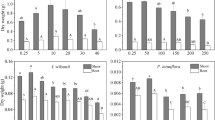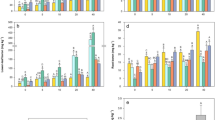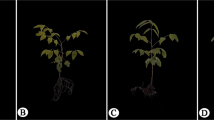Abstract
Boron is present in many household, industrial, and municipal products and by-products. Uncontrolled release of boron-containing materials into wetland environments could cause toxicity in bottomland and swamp tree species. To test this hypothesis, boron was added to 10-liter pots containing seedlings ofBetula nigra, Nyssa sylvatica var. biflora, Nyssa aquatica, Platanus occidentalis, Taxodium distichum, Quercus alba, Q. falcata var. pagodaefolia, Q. nigra, Q. michauxii, and Q. phellos at rates of 0, 2, 4, 8, and 16 mg/L, and the seedlings grown for four months. Elemental leaf concentrations, growth, and biomass were determined. Boron concentration in leaves was linearly related to boron addition. The highest boron treatment significantly decreased growth forB. nigra, N. aquatica, P. occidentalis, andT. distichum. Platanus occidentalis had the highest boron recovery (23% at 4 mg/L), whileT. distichum had the most consistent recovery (11–13%) over all treatments. Although leaf damage was severe in the oaks, there were no significant differences in growth parameters between the control and boron treatments. This is attributed to the determinate growth of the oaks and possibly the short duration of the study.
Similar content being viewed by others
Literature Cited
Artes, O.C., R.C. Ruiz, P. Zornoza, and G. Collado. 1984. A possible role for boron in higher plants. Journal of Plant Nutrition 7:1341–1354.
Atalay, A., H.E. Garrett, T.P. Mawhinney, and R.J. Mitchell. 1988. Boron fertilization and carbohydrate relations in mycorrhizal and nonmycorrhizal shortleaf pine. Tree Physiology 4:275–280.
Bible, B.B., H. Ju, and C. Chong. 1981. Boron deficiency in relation to growth and thiocyanate toxin content in radish. Scientia Horticulturae 15:201–205.
Gilliam C.H. and E.M. Smith. 1980. Sources and symptoms of boron toxicity in container grown woody ornamentals. Journal of Arboriculture 6:209–212.
Glaubig, B.A. and F.T. Bingham. 1985. Boron toxicity characteristics of four northern California endemic tree species. Journal of Environment Quality 14:72–77.
Gupta, U.C., Y.W. Jame, C.A. Campbell, A.J. Leyshon, and W. Nicholaichuk. 1985. Boron toxicity and deficiency: A review. Canadian Journal of Soil Science 65:381–409.
Kohl, H.C., Jr. and J. Oertli. 1961. Distribution of boron in leaves. Plant Physiology 36:420–424.
Kramer, P.J. and T.T. Kozlowski. 1979. Physiology of Woody Plants. Academic Press, New York, NY, USA.
Ludbrook, W.V. 1942. The effects of various concentrations of boron on the growth of pine seedlings in water culture. Journal of the Australian Institute of Agricultural Science 8:112–114.
Markert, B. 1992. Presence and significance of naturally occurring chemical elements of the periodic system in the plant organism and consequences for future investigations on inorganic environmental chemistry in ecosystems. Vegetatio 103:1–30.
Nable, R.O., G.S. Banuelos, and J.G. Paull. 1997. Boron toxicity. Plant and Soil 193:181–198.
Nielsen, F.H. 1997. Boron in human and animal nutrition. Plant and Soil 193:199–208.
Power, P.P. and W.G. Woods. 1997. The chemistry of boron and its speciation in plants. Plant and Soil 193:1–13.
Sposito, G. 1988. Boron uptake and accumulation by higher plants: a literature review. University of California, Riverside, CA, USA. EPRI/EA-5817.
Stone, E.L. 1990. Boron deficiency and excess in forest trees, a review. Forest Ecology and Management 37:49–75.
Van Mensvoort, R., S. Latin, R. Brinkman, and N. Van Bremen. 1985. Toxicities of wetland soils. p. 123–138.In Wetland Soils: Characterization, Classification, and Utilization. IRRI, Manila, Philippines.
Vimmerstedt J.P. and T.N. Glover. 1984. Boron toxicity to American sycamore of minesoil mixed with sewage sludge containing glass fibers. Soil Science Society of America Journal 48:389–393.
Wilcox, D.A. and M.A. Hardy. 1988. Effects of coal fly ash on water chemistry in an intradunal wetland at Indiana Dunes. p. 57–67.In D.A. Wilcox (ed.) Interdisciplinary Approaches to Freshwater Wetlands Research. Michigan State University Press, East Lansing, MI, USA.
Author information
Authors and Affiliations
Rights and permissions
About this article
Cite this article
McLeod, K.W., Ciravolo, T.G. Boron tolerance and potential boron removal by bottomland tree seedlings. Wetlands 18, 431–436 (1998). https://doi.org/10.1007/BF03161535
Received:
Revised:
Accepted:
Issue Date:
DOI: https://doi.org/10.1007/BF03161535




